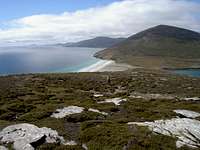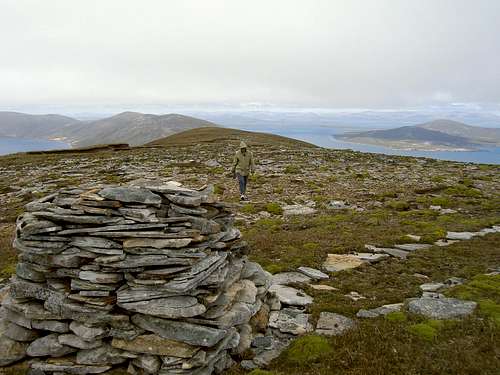-
 7847 Hits
7847 Hits
-
 88.61% Score
88.61% Score
-
 27 Votes
27 Votes
|
|
Mountain/Rock |
|---|---|
|
|
51.289°S / 60.278°W |
|
|
Hiking |
|
|
Spring, Summer |
|
|
1430 ft / 436 m |
|
|
Overview
So, before they enter the same realm (and they will), consider a trip to the wild and wonderful Falkland Islands. Barren, windswept, treeless, remote, the Islands are part of a dwindling resource; one of the last remaining chances to observe how life adapts and finds a way to flourish in a harsh and, as yet, unsullied environment. And if, like me, you like to get away from people who like to get away from people, go spend some time on Saunders Island, climb Mount Harston and marvel at the local wildlife. Harston isn’t high (the highest point on the Islands is only 705m) nor does it offer even the hint of a technical challenge but it’s wonderfully remote, the marine location is breathtaking and even the complete barrenness of the setting is compulsively attractive. All this before even mentioning the wildlife. Four species of penguin (gentoo, rockhopper, magellenic and a small colony of kings), black browed albatross, dolphins, elephant seals, cormorants and more varieties of seabird than I can name call Harston, its neighbour Rookery Mountain and the connecting spit of land between them, “The Neck”, home. The penguins have no land-based predators and, if you sit quietly, will stroll up to you and regard you with as much curiosity as you regard them.
The best time to go is early to mid December when the birds are nesting and when the weather is “mild”. In the Falklands this means 8-12 Celsius and this doesn’t take into account the ever present and substantial Antarctic wind chill. Weather patterns can change for the worse in minutes and even an easy walk like Harston can become an epic if one is not properly dressed.
Getting There
The continued unspoiled state of the Falklands owes everything to their remoteness. Since the 1982 conflict with Argentina, travel to the Islands is easier but by no means convenient. It’s also not cheap. The RAF flies six times a month from RAF Brize Norton, UK via Ascension Island and LAN Chile goes every Saturday from Santiago with stops in Puerto Montt and Punta Arenas. This means, of course, that the minimum time you’ll be there is a week. Both flights arrive at the new Mount Pleasant airport about 80km south west of the capital, Stanley. Onward travel to Saunders Island and, indeed most inter-island travel within the Islands is on FIGAS (Falkland Islands Government Air Service). This can be arranged independently but it’s much easier, since you’re sure to want to go to places other than Saunders Island, to let one of the local agencies look after everything. International Tours & Travel Ltd and Stanley Services Ltd will prepare a customized itinerary for wherever you want to go, including transfers, flights and accommodation. Note that FIGAS has a strict limitation on luggage weight at 14kg/person. More is allowed but at the discretion of the pilot and at a surcharge.Having got to Saunders, you’re not quite there yet. Mount Harston lies approximately 15km north west of the settlement over a jeep track of sorts. The owners of the Island will drive you out there in a little over an hour for about £40 or you can walk. I recommend you have everything pre-arranged via one of the above agencies.
Red Tape
Entry into the Falklands is as for the UK. For most nationalities this means a passport but a visa is required for nationals of some countries. Enquire at your local UK consulate. A condition of landing on the Islands is that you have a return ticket, funds to cover your expenses whilst there and accommodation reserved for at least the first 2 or 3 nights of your stay. In practice, if you arrive without a reservation, the nice immigration people phone around Stanley until they find someone with a bed available before letting you out of the airport. Like almost all land in the Falklands, Saunders Island is privately owned. Any activities you undertake on the island must be with the permission of the Pole-Evans family. Unless you decide to walk out to the Neck, Dave, Susan, Carol or Biffo will be your driver. You can discuss planned activities at that time.It goes without saying that photographing any of the military installations around the islands is strictly forbidden. In case anyone is foolish enough to consider otherwise, entering a marked minefield is illegal and carries a heavy fine (or worse!)
Camping/Accommodation
Some visitors do go out to the Neck and Mt Harston as a day trip from the settlement on Saunders. However, I recommend spending at least 3 nights there. There can be few places in the world as accessible (well relatively) as this, where you can be lulled to sleep by the sound of the gentle piping of hundreds of gentoos in concert with the crashing of the ocean. This is truly a magical place and one where one feels privileged to be. Savour your all too brief time there.With the permission of the Pole-Evans, it is possible to camp, although shelter from the ever present wind and the proximity of fresh water are issues to be considered. The best place is under a rock overhang on the lower slopes of Mt Harston known as the “Swiss Hotel” – so called after its use by a group of Swiss photographers from a few years back. They even left a very artistic metal sign. Much better, however, is the portakabin installed and equipped by the Pole-Evans. This is basic but offers surprising comfort for such a remote spot. It has two bunkrooms, each sleeping four, a communal kitchen and a bathroom with a real bath. Power is 12V solar; there is no facility to recharge camera batteries, so be prepared. Food is available for purchase from the small store in the settlement. This is important because of FIGAS’ strict limit on luggage weight. Again, I recommend making all bookings and payment in advance via one of the Stanley agencies.
The Route
From “The Neck”, the isthmus of sand connecting Mount Harston and Mt Richards, walk northwest up the broad open slopes of the mountain. There is no trail, nor is one needed. The harshness of the environment means that ground cover is sparse and the going easy and open. Be careful not to disturb the magellenic penguins in their burrows on the lower slopes.About an hour of easy walking gets you onto an open ridge with views down to the sea east and west and with the “stone man” summit cairn in view. Another 15 minutes gets you to the top. The views in all directions are spectacular. If the weather looks promising I particularly recommend walking up in the evening for the light quality. At this hour of the day, the views north to Carcass Island and beyond to the Jason Islands beggar description.
Make the walk a round trip by descending from the summit northwards towards Elephant Point. This is possible along the upland ridges to the north before they run down to the sea at the Point or by dropping down any of the hanging valleys off the ridges through "fields" of balsam bog to intersect the coast south of the Point. As you approach the coast watch out for dive-bombing skua gulls. Skuas are fond of raiding other birds’ nests but protect their own aggressively. Wear a hat and wave your arms a lot! Approach any sea elephants at the Point with extreme caution. Return to the Neck southwards along the seashore or back over Harston to enjoy those views once more. The round trip walk takes a leisurely 4-5 hours.
External Links
If you’re making the long trip down to the Falklands, you’ll certainly want to see more than just Saunders Island and Mt Harston. An excellent website to begin your research is run by Horizon, the Islands' Cable and Wireless company, internet provider etc. Visit their Falkland Islands websiteFor more details and pictures of Saunders Island visit this website












